tow bar CITROEN JUMPY 2008 Owners Manual
[x] Cancel search | Manufacturer: CITROEN, Model Year: 2008, Model line: JUMPY, Model: CITROEN JUMPY 2008Pages: 252, PDF Size: 12.15 MB
Page 88 of 252
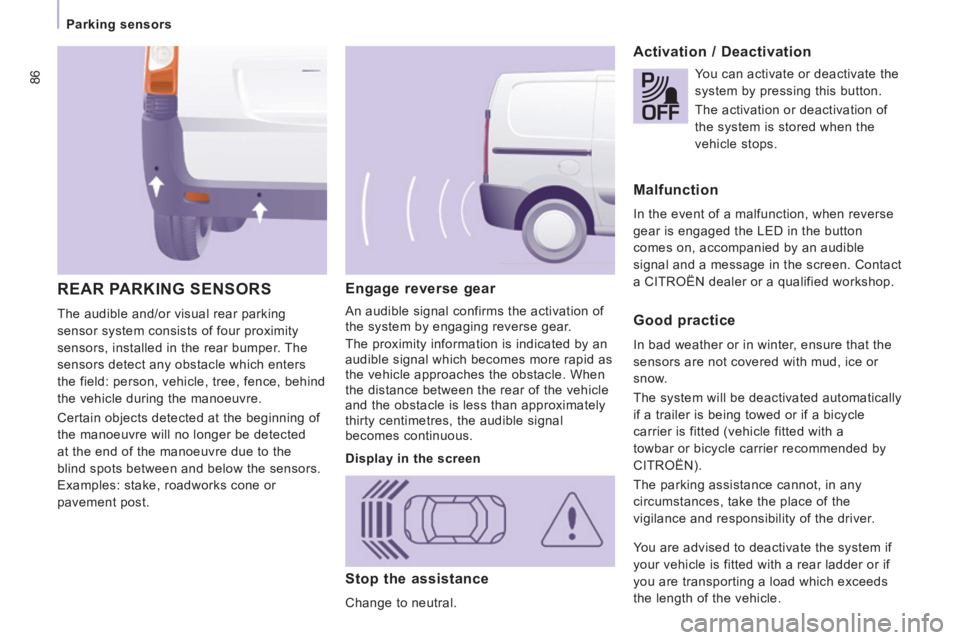
86
Parking sensors
Engage reverse gear
An audible signal confirms the activation of
the system by engaging reverse gear.
The proximity information is indicated by an
audible signal which becomes more rapid as
the vehicle approaches the obstacle. When
the distance between the rear of the vehicle
and the obstacle is less than approximately
thirty centimetres, the audible signal
becomes continuous.
Stop the assistance
Change to neutral.
REAR PARKING SENSORS
The audible and/or visual rear parking
sensor system consists of four proximity
sensors, installed in the rear bumper. The
sensors detect any obstacle which enters
the field: person, vehicle, tree, fence, behind
the vehicle during the manoeuvre.
Certain objects detected at the beginning of
the manoeuvre will no longer be detected
at the end of the manoeuvre due to the
blind spots between and below the sensors.
Examples: stake, roadworks cone or
pavement post.
Activation / Deactivation
You can activate or deactivate the
system by pressing this button.
The activation or deactivation of
the system is stored when the
vehicle stops.
Malfunction
In the event of a malfunction, when reverse
gear is engaged the LED in the button
comes on, accompanied by an audible
signal and a message in the screen. Contact
a CITROËN dealer or a qualified workshop.
Good practice
In bad weather or in winter, ensure that the
sensors are not covered with mud, ice or
snow.
The system will be deactivated automatically
if a trailer is being towed or if a bicycle
carrier is fitted (vehicle fitted with a
towbar or bicycle carrier recommended by
CITROËN).
The parking assistance cannot, in any
circumstances, take the place of the
vigilance and responsibility of the driver.
Display in the screen
You are advised to deactivate the system if
your vehicle is fitted with a rear ladder or if
you are transporting a load which exceeds
the length of the vehicle.
Page 108 of 252
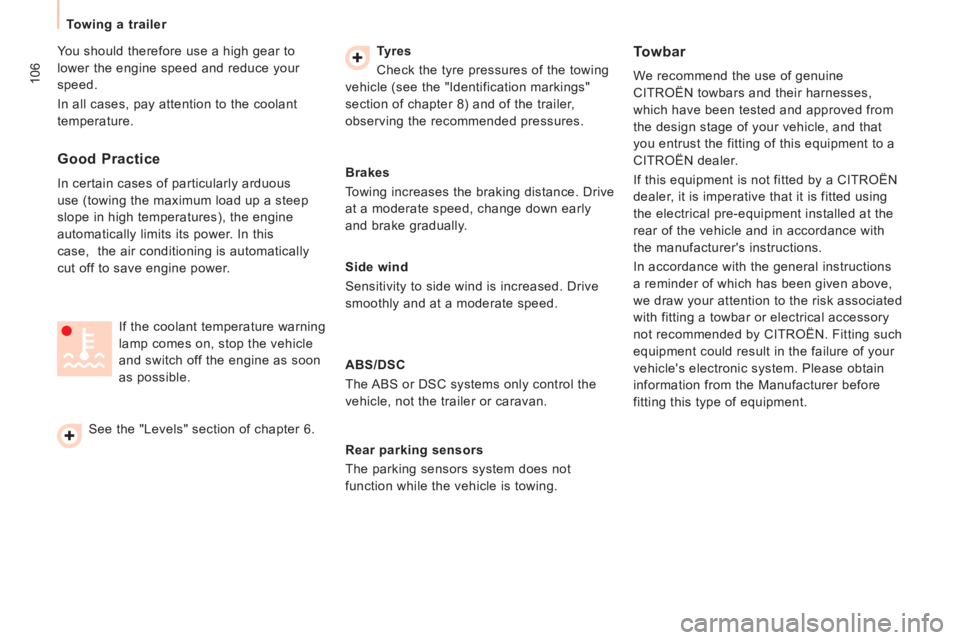
106
Towing a trailer
You should therefore use a high gear to
lower the engine speed and reduce your
speed.
In all cases, pay attention to the coolant
temperature. Tyres
Check the tyre pressures of the towing
vehicle (see the "Identification markings"
section of chapter 8) and of the trailer,
observing the recommended pressures.
Towbar
We recommend the use of genuine
CITROËN towbars and their harnesses,
which have been tested and approved from
the design stage of your vehicle, and that
you entrust the fitting of this equipment to a
CITROËN dealer.
If this equipment is not fitted by a CITROËN
dealer, it is imperative that it is fitted using
the electrical pre-equipment installed at the
rear of the vehicle and in accordance with
the manufacturer's instructions.
In accordance with the general instructions
a reminder of which has been given above,
we draw your attention to the risk associated
with fitting a towbar or electrical accessory
not recommended by CITROËN. Fitting such
equipment could result in the failure of your
vehicle's electronic system. Please obtain
information from the Manufacturer before
fitting this type of equipment.
See the "Levels" section of chapter 6.
Good Practice
In certain cases of particularly arduous
use (towing the maximum load up a steep
slope in high temperatures), the engine
automatically limits its power. In this
case, the air conditioning is automatically
cut off to save engine power.
If the coolant temperature warning
lamp comes on, stop the vehicle
and switch off the engine as soon
as possible. Brakes
Towing increases the braking distance. Drive
at a moderate speed, change down early
and brake gradually.
Side wind
Sensitivity to side wind is increased. Drive
smoothly and at a moderate speed.
ABS/DSC
The ABS or DSC systems only control the
vehicle, not the trailer or caravan.
Rear parking sensors
The parking sensors system does not
function while the vehicle is towing.
Page 110 of 252

108
Equipment The fitting of electrical equipment
or accessories which are not
recommended by CITROËN may result
in the failure of your vehicle's electronic
system. Please note this specific warning.
You are advised to contact a representative
of the Marque to be shown the range of
recommended equipment and accessories.
Depending on the country in which the
vehicle is sold or operated, it is compulsory
to have a high visibility safety vest, warning
triangle and replacement bulbs available in
the vehicle.
Installation of radiocommunication
transmitters
Before installing accessory
radiocommunication transmitters with an
external aerial on your vehicle, you are
advised to contact a representative of the
CITROËN marque.
The CITROËN dealer network can inform
you of the specifications (frequency
band, maximum output power, aerial
position, specific installation conditions)
of the transmitters which can be fitted,
in accordance with the Motor Vehicle
Electromagnetic Compatibility Directive
(2004/104/CE). Front mud flaps, rear mud flaps, ...
Range of trade
equipment
Parts and Services technical information
publishes an accessory catalogue offering
various equipment and fittings, such as:
Screenwash, replacement fuses, wiper
blades, interior and exterior cleaning
and maintenance products, replacement
bulbs, ...
Roof bars for short, medium and long
wheelbase (load retainers for all models).
Towbar, towbar harness: trailer towbar which must be fi tted by the network.
Sill plate, loading roller, sill. Sill plate,
loading roller, sill.
Roof bars for the various heights, roof bars,
ladder.
Separation partitions and grilles, smooth,
non-slip wooden protective floor.
Protective grilles, multimedia.
Another range is also available, structured
around comfort, leisure and maintenance:
Anti-theft alarm, window engraving, first aid
kit, high visibility safety vest, rear parking
sensors, warning triangle, ...
Front seat covers compatible with airbags,
bench, rubber mats, carpet mats, snow
chains. To prevent the mat from becoming caught
under the pedals:
- ensure that the mat and its fi xings are
positioned correctly,
- never fi t one mat on top of another.
Audio equipment, hands-free kit, speakers,
CD changer, navigation, ...
Regardless of the audio and telematic
equipment offered on the market, the
technical constraints linked with the fi tting of
equipment of these families of products mean
that the special features of the equipment and
its compatibility with the capacities of the your
vehicle's standard equipment must be taken
into account. Please contact a dealer for
information before fi tting such equipment.
Page 137 of 252

135
Changing a fuse
QUICK HELP
7
CHANGING A FUSE
The three fuseboxes are placed:
- in the dashboard on the right-hand side (behind the storage compartments,
retractable),
- in the passenger compartment (battery compartment),
- under the bonnet.
If fitted on your vehicle, a further fusebox
is added for towing, the towbar and the
connections for the coachbuilder and
platform cab conversions. It is located on the
right behind the load retaining partition.
Removing and fitting a fuse
Before changing a fuse, the cause of the
fault must be found and rectified. Always replace a failed fuse with a fuse
of the same rating.
CITROËN will not accept responsibility
for the cost incurred in repairing your
vehicle or for rectifying the malfunctions
resulting from the installation of accessories
not supplied and not recommended by
CITROËN and not installed in accordance
with its instructions, in particular when
the combined consumption of all of the
additional equipment connected exceeds
10 milliamperes.
The descriptions communicated are only the
fuses which can be changed by the user.
For any other operations, go to a CITROËN
dealer or a qualified workshop.
For motor trade use: for complete
fuse and relay information, consult the
"Repair procedure" wiring diagrams via the
dealer network.
Page 141 of 252
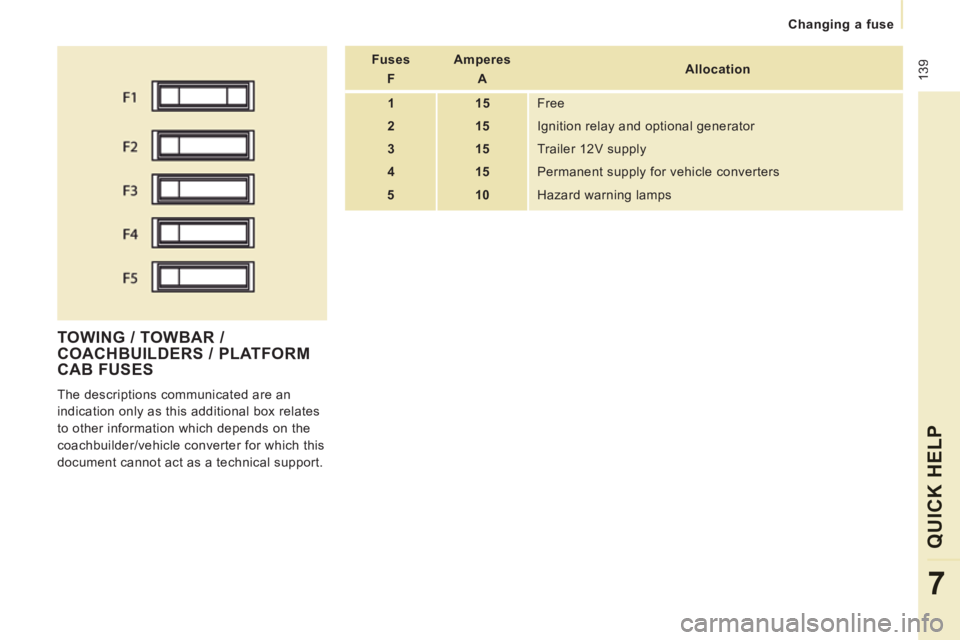
139
Changing a fuse
QUICK HELP
7
TOWING / TOWBAR / COACHBUILDERS / PLATFORM CAB FUSES
The descriptions communicated are an
indication only as this additional box relates
to other information which depends on the
coachbuilder/vehicle converter for which this
document cannot act as a technical support. Fuses
F Amperes
A Allocation
1 15 Free
2 15 Ignition relay and optional generator
3 15 Trailer 12V supply
4 15 Permanent supply for vehicle converters
5 10 Hazard warning lamps
Page 143 of 252

141
Having your vehicle towed
QUICK HELP
7
Without lifting (4 wheels on the
ground)
You should always use a towing bar.
From the front
- Unclip the cover by pressing at the bottom,
- Fully screw in the removable towing eye.
TOWING THE VEHICLE
Lifting (2 wheels on the ground
only)
It is preferable to lift the vehicle using
professional lifting equipment.
From the rear
- Unclip the cover using a coin or the flat part of the towing eye,
- Fully screw in the removable towing eye.
Vehicles fitted with a manual
gearbox (Diesel version)
In the case of vehicles fitted with a manual
gearbox, the gear lever must be in the
neutral position. Failure to observe this
special condition may result in damage
to certain braking components and the
absence of braking assistance the next time
the engine is started.
Page 144 of 252
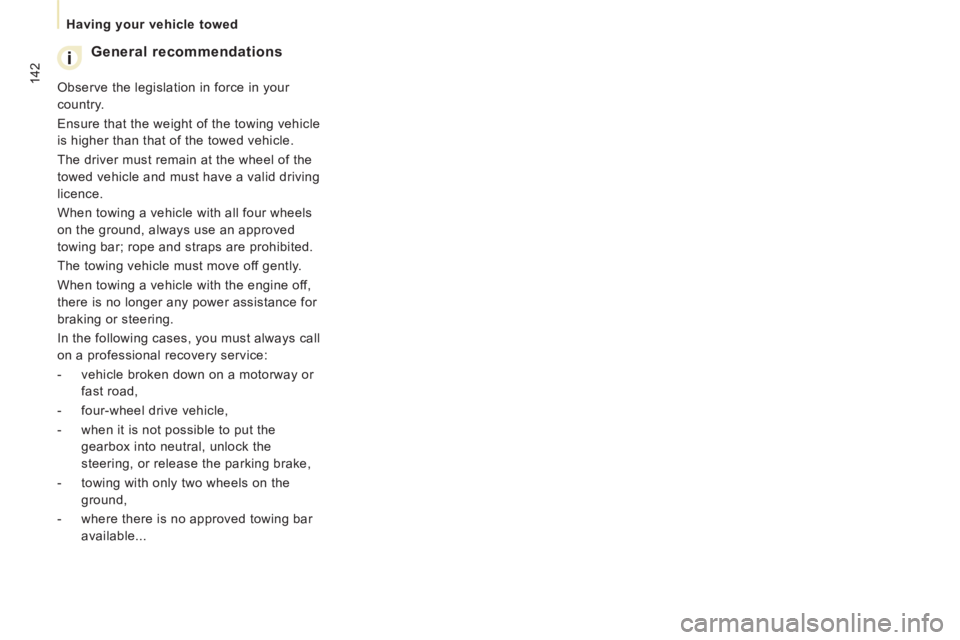
142
Having your vehicle towed
General recommendations
Observe the legislation in force in your
country.
Ensure that the weight of the towing vehicle
is higher than that of the towed vehicle.
The driver must remain at the wheel of the
towed vehicle and must have a valid driving
licence.
When towing a vehicle with all four wheels
on the ground, always use an approved
towing bar; rope and straps are prohibited.
The towing vehicle must move off gently.
When towing a vehicle with the engine off,
there is no longer any power assistance for
braking or steering.
In the following cases, you must always call
on a professional recovery service:
- vehicle broken down on a motorway or fast road,
- four-wheel drive vehicle,
- when it is not possible to put the gearbox into neutral, unlock the
steering, or release the parking brake,
- towing with only two wheels on the ground,
- where there is no approved towing bar available...
Page 239 of 252
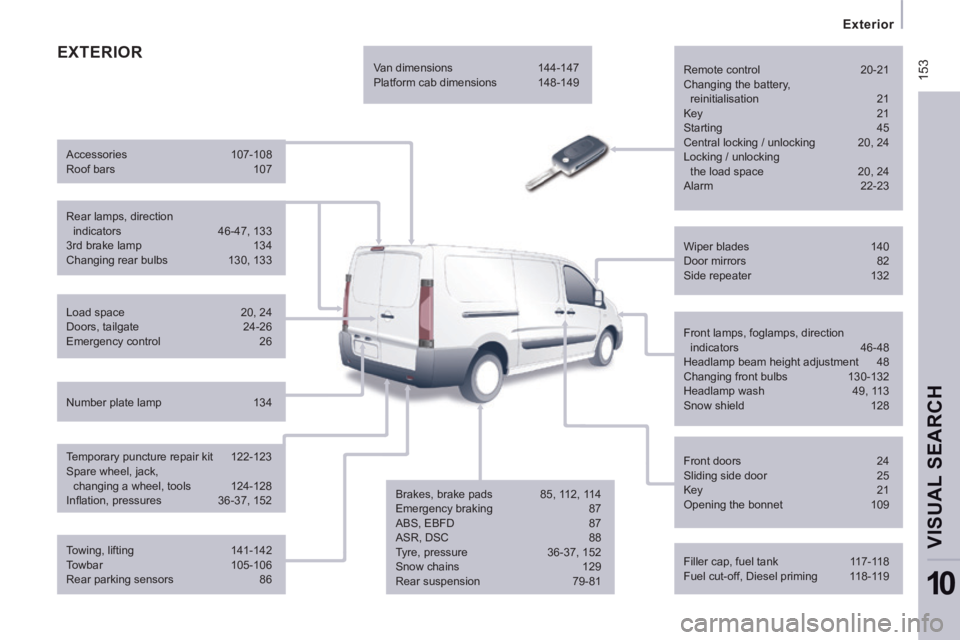
153
Exterior
VISUAL SEARCH
10
EXTERIOR Remote control 20-21
Changing the battery,
reinitialisation 21 Key 21
Starting 45
Central locking / unlocking 20, 24
Locking / unlocking the load space 20, 24
Alarm 22-23
Filler cap, fuel tank 117-118
Fuel cut-off, Diesel priming 118-119 Wiper blades 140
Door mirrors 82
Side repeater 132
Front lamps, foglamps, direction indicators 46-48
Headlamp beam height adjustment 48
Changing front bulbs 130-132
Headlamp wash 49, 113
Snow shield 128
Front doors 24
Sliding side door 25
Key 21
Opening the bonnet 109
Towing, lifting 141-142
Towbar 105-106
Rear parking sensors 86
Load space
20, 24
Doors, tailgate 24-26
Emergency control 26
Temporary puncture repair kit 122-123
Spare wheel, jack, changing a wheel, tools 124-128
Infl ation, pressures 36-37, 152 Rear lamps, direction indicators 46-47, 133
3rd brake lamp 134
Changing rear bulbs 130, 133
Accessories
107-108
Roof bars 107
Number plate lamp 134 Van dimensions
144-147
Platform cab dimensions 148-149
Brakes, brake pads 85, 112, 114
Emergency braking 87
ABS, EBFD 87
ASR, DSC 88
Tyre, pressure 36-37, 152
Snow chains 129
Rear suspension 79-81
Page 242 of 252
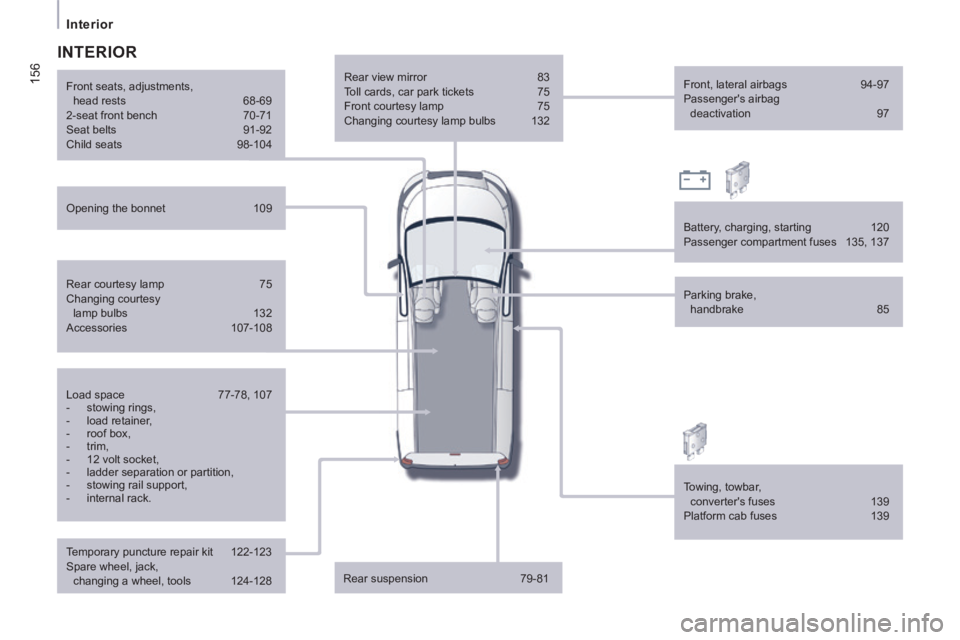
156
Interior
Temporary puncture repair kit 122-123
Spare wheel, jack, changing a wheel, tools 124-128 Rear view mirror
83
Toll cards, car park tickets 75
Front courtesy lamp 75
Changing courtesy lamp bulbs 132
Rear suspension 79-81 Front, lateral airbags
94-97
Passenger's airbag deactivation 97
Front seats, adjustments,
head rests 68-69
2-seat front bench 70-71
Seat belts 91-92
Battery, charging, starting 120
Passenger compartment fuses 135, 137
INTERIOR
Opening the bonnet 109
Child seats
98-104
Rear courtesy lamp 75
Changing courtesy lamp bulbs 132
Accessories 107-108
Load space 77-78, 107
- stowing rings,
- load retainer,
- roof box,
- trim,
- 12 volt socket,
- ladder separation or partition,
- stowing rail support,
- internal rack. Towing, towbar,
converter's fuses 139
Platform cab fuses 139
Parking brake,
handbrake 85